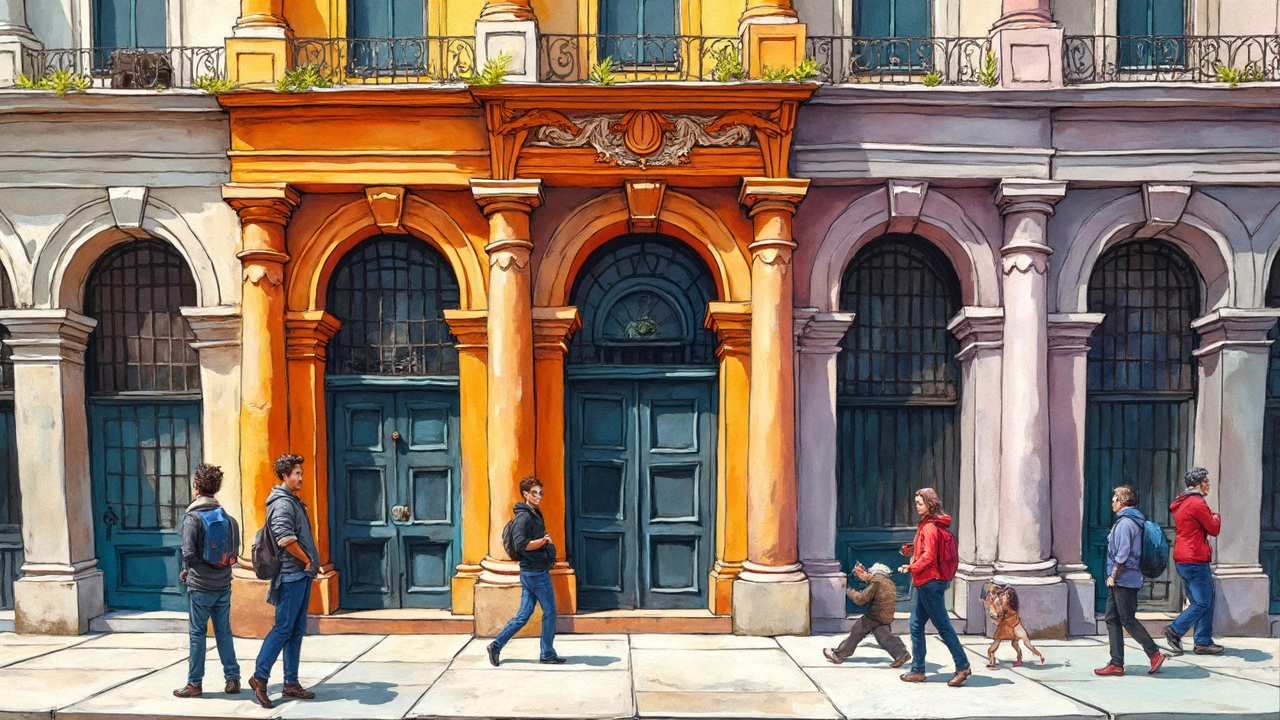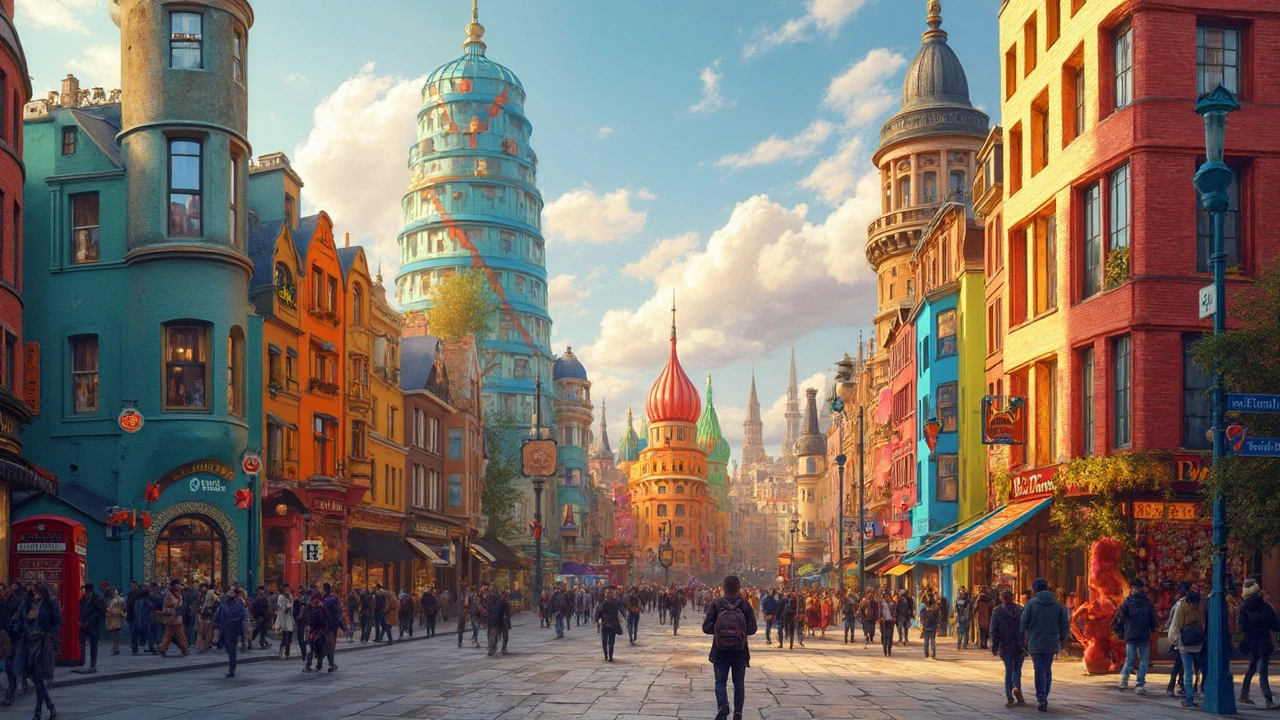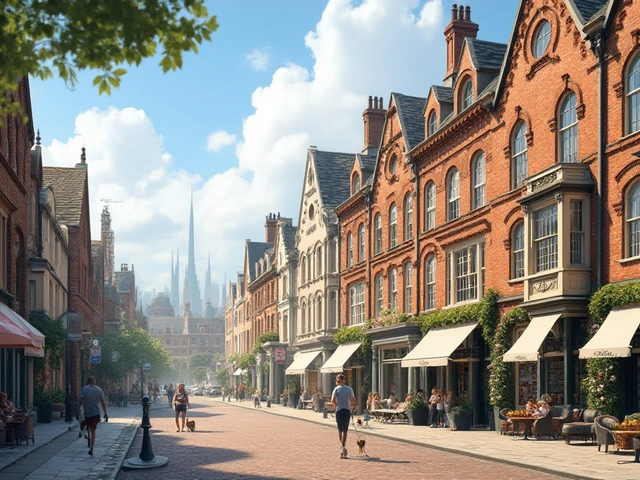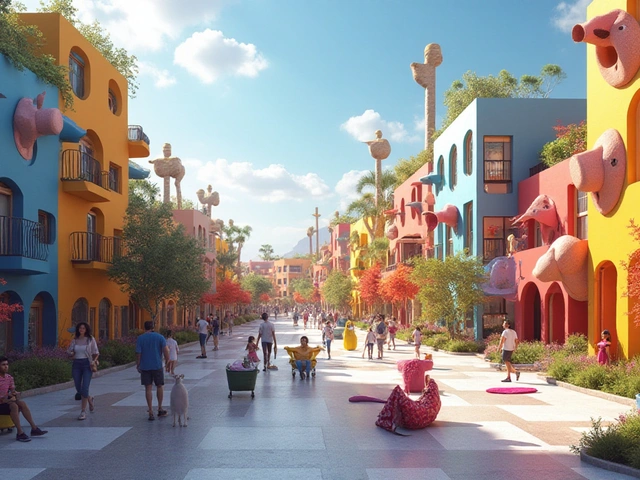Forget everything you think you know about 'serious' architecture. Postmodern design didn’t just bend the rules—it busted through them, mixing old and new, bright colors with classic columns, and weird shapes with a wink. Think of a building that looks like it’s having way more fun than the people walking by. That’s postmodern for you.
If you’ve ever thought, ‘Why does that office tower have a giant cartoon-like roof?’ or ‘Is that a building or a giant piece of sculpture?’—chances are, you’ve run into postmodern architecture. Architects in the 1970s and '80s were bored of the plain glass-and-steel boxes from the Modernist era. They wanted to rebel, so they brought back wild shapes, bright colors, and jokes baked right into the walls.
Before you head outside and start snapping photos, there’s more to learn. Not all funky buildings are postmodern, but every postmodern building is trying to say something—sometimes even poking fun at itself. Stick around, because the next time you turn a corner and spot a building with a unicorn on the roof (yes, that happens), you’ll know exactly what’s up.
- What Sparked the Postmodern Movement?
- Key Features That Set Postmodernism Apart
- Famous Postmodern Buildings You Can Visit
- How Postmodern Design Changed Cities
- Tips for Spotting Postmodern Architecture
- Postmodern Influence in Today’s Designs
What Sparked the Postmodern Movement?
The shift to postmodern architecture didn’t happen overnight. By the late 1960s, a lot of architects and regular folks alike were completely bored with Modernism. Modernist buildings—think plain glass boxes and endless concrete—started to look cold, dull, and basically the same everywhere, from Tokyo to New York. The real trigger came when architects wanted buildings to connect more with people instead of just looking sleek and high-tech.
One name that pops up right away is Robert Venturi. In 1966, he dropped a bombshell with his book Complexity and Contradiction in Architecture. He basically told the design world, “Hey, it’s okay to mix styles, break rules, and bring back some fun.” This book became the rallying cry for something different. Shortly after, Denise Scott Brown, Charles Moore, and Michael Graves started to add their own spin, bringing in weird shapes, colorful patterns, and even jokes into buildings.
The oil crisis of the 1970s actually pushed things along. With money tighter, clients wanted practical buildings but also something attention-grabbing that would make them stand out. Architects began to see that rules weren’t laws—they were more like guidelines. The lookbook grew to include past styles and pop culture references. Suddenly it wasn’t weird to see a Greek column next to mirrored glass.
The numbers say it all. By the 1980s, postmodern buildings were popping up across North America and Europe. Check out this quick comparison:
| Year | # of Major Modernist Buildings Built | # of Major Postmodern Buildings Built |
|---|---|---|
| 1965 | 35 | 3 |
| 1975 | 22 | 15 |
| 1985 | 10 | 42 |
If you’re looking for that turning point, the 1980s pretty much sealed the deal: postmodern architecture was officially a thing, showing up in city skylines, offices, and even suburban homes. And just like that, architecture started to look more personal, local, and sometimes downright weird—in the best way possible.
Key Features That Set Postmodernism Apart
What makes a building postmodern? It’s not just crazy angles or odd colors—it’s more about breaking the old rules. The first thing you’ll notice is that postmodern architecture doesn’t like to take itself too seriously. Instead of cold, glass boxes, you get buildings that mix styles, mess with history, and add a dash of humor.
Unlike the strict lines of modernism, postmodern buildings might have arches pulled from Roman times, bright pink walls, or windows shaped like portholes. Some even have details that are almost cartoonish. The idea was to make architecture feel more playful, human, and unexpected.
- Postmodern architecture is famous for its mix of old and new. You’ll see classical columns smashed against steel and concrete, or a building shaped like an everyday object, like a duck or a shopping bag.
- Color is a big deal—pastels, bold blues, and even neon shades get used on exteriors and interiors. This wasn’t common before.
- Buildings often have motifs or details that look like they came from history—or a comic book. Think of Michael Graves’ Portland Building, with its oversized decorations and teal stripes.
- Ornament is back. While modernism stripped buildings down, postmodernism went wild with fake columns, sculptures, and pop culture references.
All of this shook up the design world. Between 1975 and 1995, the number of architecturally recognized postmodern buildings in North America tripled—a huge spike after decades of minimalism.
| Feature | Modernism | Postmodernism |
|---|---|---|
| Ornament | None | Lots—sometimes over the top |
| Colors | Mostly neutral gray, black, white | Brave use of bright color |
| Materials | Glass, steel, concrete | Mixed—stone, tile, brick, glass, metal |
| Shapes | Straight, simple forms | Complex, playful, often odd |
| References | Avoided history | Loved quotes from history and pop culture |
If you’re walking down the street and notice a building that sticks out in a weird but interesting way, check the details. Is it borrowing from the past and mashing it up with modern parts? Is there a sense of fun? It’s likely postmodern. Knowing these features helps you spot the real thing right away.
Famous Postmodern Buildings You Can Visit
If you want to see postmodern architecture up close, there’s no shortage of wild and clever buildings that put this trend on the map. These places aren’t just famous—they show exactly how postmodern style shakes things up.
Here are a few must-see buildings and why they’re worth a visit:
- Portland Building, Portland, Oregon, USA
Designed by Michael Graves and finished in 1982, this concrete-and-glass box has pastel colors, bold shapes, and fake columns. Some folks think it looks like a toy block fort, but it changed American architecture forever. It actually got a major renovation in 2020 to update its inside systems. - Piazza d’Italia, New Orleans, Louisiana, USA
Charles Moore designed this 1978 plaza to celebrate Italian-American culture. You’ll find Roman columns and neon lights mixed with water fountains. This public space just screams "postmodern mix and match." It’s still used for outdoor events and hangouts. - AT&T Building (now 550 Madison Avenue), New York City, USA
This Philip Johnson 1984 skyscraper stands out because of the “Chippendale” pediment at the top that looks a bit like a highboy dresser. The controversy was huge but now it’s a classic and was landmarked in 2018. - MI6 Building, London, UK
Known as the headquarters of the British Secret Intelligence Service, this 1994 building by Terry Farrell has bold, stepped layers and a chunky, fortress-like look. Fans of James Bond movies will recognize it right away, but even up close, it’s just as dramatic. - Sony Tower, Tokyo, Japan
Finished in 1976 by Yoshinobu Ashihara, this building uses a playful facade and curved edges to show off Japanese postmodern style. The inside is just as creative, with shops and open spaces for people to mingle.
Here’s a quick comparison table with dates, architects, and standout features so you can plan your architecture nerd tour:
| Building | Location | Year Finished | Architect | What Makes It Unique |
|---|---|---|---|---|
| Portland Building | Portland, USA | 1982 | Michael Graves | Colorful geometric shapes, toy-like appearance |
| Piazza d’Italia | New Orleans, USA | 1978 | Charles Moore | Neon, columns, lively public space |
| AT&T Building (550 Madison Ave) | New York City, USA | 1984 | Philip Johnson | Chippendale top, historic landmark |
| MI6 Building | London, UK | 1994 | Terry Farrell | Layered fortress look, Bond fame |
| Sony Tower | Tokyo, Japan | 1976 | Yoshinobu Ashihara | Curved shapes, busy interactive spaces |
If you’re traveling, pop these spots on your list. And don’t forget to look out for quirky colors, clashing styles, and a sense of humor—those are the tell-tale postmodern signs.

How Postmodern Design Changed Cities
When postmodern architects started popping up on city skylines in the late 1970s, everything looked different—fast. Sleek glass rectangles made way for buildings that grabbed your attention with bold colors, weird shapes, and mashups of old and new styles. All of a sudden, cities weren’t just practical; they felt like giant art galleries.
One of the most noticeable changes was how public spaces became more playful. Office lobbies started looking like movie sets. Parks got sculptures that looked straight out of a cartoon. Even shopping malls turned into places people actually wanted to hang out—not just race through. Take the Piazza d’Italia in New Orleans, for example. When it opened in 1978, folks didn’t know whether to take it seriously or laugh out loud. But it drew crowds exactly because of its bold, tongue-in-cheek vibe.
Some city planners worried that postmodern buildings would stick out like sore thumbs. In fact, many of these wild projects—like Philip Johnson’s AT&T Building in New York, with its iconic “Chippendale” top—became instant landmarks. People started gathering around them, and neighborhoods saw more foot traffic. Real estate numbers actually improved in some areas once they got a signature postmodern spot.
| Famous Postmodern City Buildings | City | Year Completed |
|---|---|---|
| AT&T Building (now Sony Tower) | New York City | 1984 |
| Piazza d’Italia | New Orleans | 1978 |
| Portland Building | Portland, OR | 1982 |
| Bank of America Tower (formerly BofA Plaza) | Atlanta | 1992 |
The postmodern architecture vibe even influenced zoning. Some cities relaxed regulations so buildings could get more personality. Instead of blending in, architects started making bold statements, which encouraged rival firms to dream up even crazier ideas. Think of it as one big, playful game of architectural one-upmanship.
If you're walking around a city built before the 1980s, then spot a sudden burst of color or an oddball sculpture topping a building, there’s a good chance you’re seeing postmodern influence at work. It shook up what people expected from urban design and, honestly, made cities a whole lot less dull.
Tips for Spotting Postmodern Architecture
If you want to tell if a building belongs to the postmodern architecture movement, check for these hallmarks. Unlike earlier styles that play it safe, postmodern buildings love to surprise you. Here’s what to look out for when you’re wandering around your neighborhood or traveling in a new city.
- Unexpected Shapes and Playful Mixes: If the building looks like it’s breaking free from the shape of a normal box, that’s a good hint. Think angles that pop out, curves, or mash-ups of different forms jammed together.
- Color Combos That Grab You: Postmodern buildings often use bright, bold colors or even clashing combos. This isn’t the era of gray and beige – look for punches of red, blue, or even teal.
- Borrowed Classical Features: You’ll spot columns, arches, or little bits from ancient Greece or Rome, only they’re kind of exaggerated or intentionally over-the-top. Sometimes, it feels like the building is making a joke about the past.
- Decorations and Surface Details: Ornament is back! Postmodern facades tend to feature patterns, mosaics, or even giant sculptures glued onto the outer walls.
- Hidden Messages and Jokes: Many postmodern architects had a sense of humor. Look up at the roofline or tucked-away corners for quirky details, symbols, or references – often there just for fun.
One cool fact: The Portland Building in Oregon, finished in 1982, is a textbook example. Designed by Michael Graves, it has colorful stripes, fake columns, and reliefs that look more like cartoon versions of ancient buildings than anything serious.
For a quick cheat sheet, check out this table with famous postmodern buildings and what makes them stand out:
| Building Name | Location | Signature Postmodern Features |
|---|---|---|
| Portland Building | Portland, USA | Colorful façade, stylized columns, playful ornamentation |
| Piazza d’Italia | New Orleans, USA | Fake ruins, neon lights, playful Italian references |
| AT&T Building (Sony Tower) | New York, USA | Chippendale-style broken pediment top, granite cladding |
| MI6 Building | London, UK | Stacked boxy forms, bold colors, fortress-like look |
Next time you’re on a city walk, use these signs and the table above to spot postmodern buildings. It’s like a treasure hunt for anything weird, colorful, or tongue-in-cheek. And don’t be afraid to take photos—some buildings are almost begging to be shared!
Postmodern Influence in Today’s Designs
If you think postmodernism is stuck in the past, take another look at the buildings popping up in your city. Postmodern quirks are everywhere, just updated for today’s tastes. Designers still mix bold colors, playful shapes, and clever references to famous architecture, but now they blend in eco-friendly materials and techy upgrades.
Big-name architects like Frank Gehry and Rem Koolhaas were shaped by the postmodern wave. Gehry’s Walt Disney Concert Hall in Los Angeles, with its metallic swoops and surprise angles, is a direct nod to this style. Even new Starbucks stores sometimes play with unexpected rooflines and mix-and-match facades—keeping things fresh instead of boring.
- Bright pops of color are back, especially in housing projects and public spaces.
- You’ll notice old-school columns or arches, but they’re used in funky places—like the inside of a tech startup’s office or a school library.
- Mixing high and low: Expensive materials set right next to simple concrete or recycled wood.
- Lots of inside jokes and hidden messages in murals or building details.
The stats back this up. A 2023 survey by Architectural Digest found that over 40% of new commercial projects in major cities had "postmodern-inspired" design features. Chunky facades, creative windows, and color-blocking top the list. Here’s a snapshot:
| Element | Share of Projects (2023) |
|---|---|
| Color Blocking | 43% |
| Playful Shapes | 37% |
| Historical Screens/Layers | 32% |
| Mix of Materials | 45% |
Why does postmodern architecture keep sneaking back in? People want variety instead of cookie-cutter buildings. Instagram culture feeds on unique backdrops, and honestly, it just feels good to work, shop, or live somewhere with personality.
If you’re into experimenting with design at home, snag some postmodern inspiration: a pop of bright color, a wavy lamp, or geometric shelves can give any room a quirky upgrade. Even small touches—a patterned rug or a playful chair—bring the spirit of postmodernism without costing a fortune.




